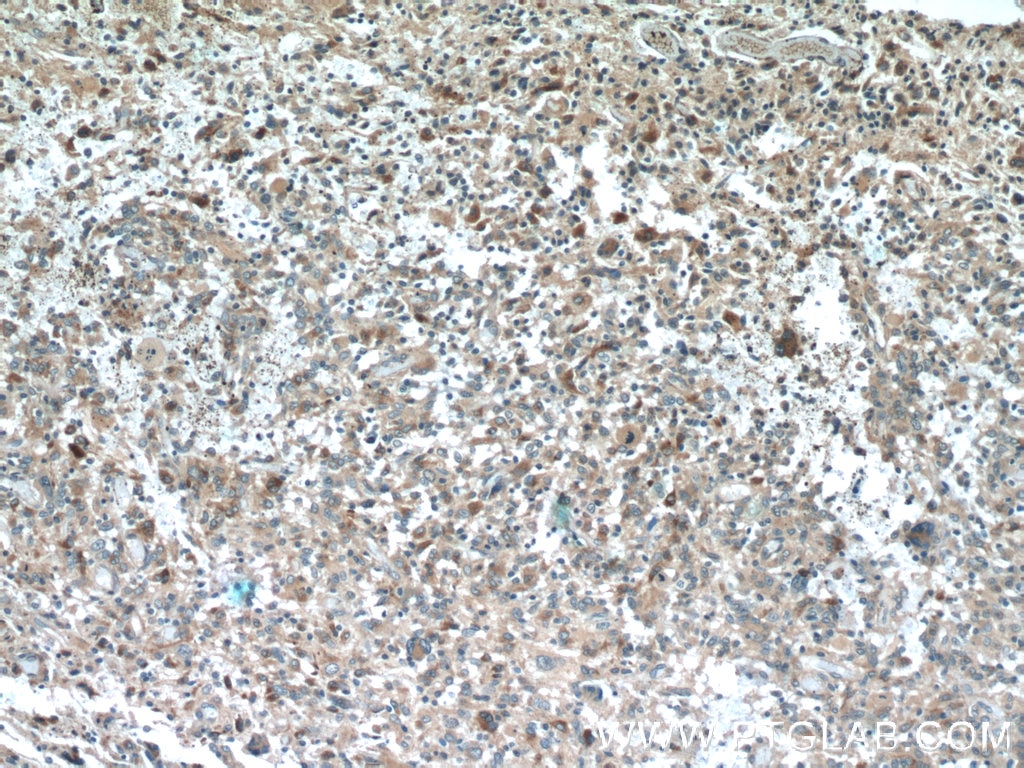SPARCL1 Polyklonaler Antikörper
SPARCL1 Polyklonal Antikörper für WB, IP, IHC, ELISA
Wirt / Isotyp
Kaninchen / IgG
Getestete Reaktivität
human und mehr (1)
Anwendung
WB, IHC, IP, ELISA, IF
Konjugation
Unkonjugiert
Kat-Nr. : 13517-1-AP
Synonyme
Galerie der Validierungsdaten
Geprüfte Anwendungen
| Erfolgreiche Detektion in WB | humanes Herzgewebe |
| Erfolgreiche IP | Raji-Zellen |
| Erfolgreiche Detektion in IHC | humanes Tonsillitisgewebe, humanes Gliomgewebe Hinweis: Antigendemaskierung mit TE-Puffer pH 9,0 empfohlen. (*) Wahlweise kann die Antigendemaskierung auch mit Citratpuffer pH 6,0 erfolgen. |
Empfohlene Verdünnung
| Anwendung | Verdünnung |
|---|---|
| Western Blot (WB) | WB : 1:500-1:2000 |
| Immunpräzipitation (IP) | IP : 0.5-4.0 ug for 1.0-3.0 mg of total protein lysate |
| Immunhistochemie (IHC) | IHC : 1:50-1:500 |
| It is recommended that this reagent should be titrated in each testing system to obtain optimal results. | |
| Sample-dependent, check data in validation data gallery | |
Veröffentlichte Anwendungen
| WB | See 5 publications below |
| IHC | See 2 publications below |
| IF | See 1 publications below |
Produktinformation
13517-1-AP bindet in WB, IHC, IP, ELISA, IF SPARCL1 und zeigt Reaktivität mit human
| Getestete Reaktivität | human |
| In Publikationen genannte Reaktivität | human, Maus |
| Wirt / Isotyp | Kaninchen / IgG |
| Klonalität | Polyklonal |
| Typ | Antikörper |
| Immunogen | SPARCL1 fusion protein Ag4448 |
| Vollständiger Name | SPARC-like 1 (hevin) |
| Berechnetes Molekulargewicht | 664 aa, 75 kDa |
| Beobachtetes Molekulargewicht | 130-140 kDa |
| GenBank-Zugangsnummer | BC033721 |
| Gene symbol | SPARCL1 |
| Gene ID (NCBI) | 8404 |
| Konjugation | Unkonjugiert |
| Form | Liquid |
| Reinigungsmethode | Antigen-Affinitätsreinigung |
| Lagerungspuffer | PBS mit 0.02% Natriumazid und 50% Glycerin pH 7.3. |
| Lagerungsbedingungen | Bei -20°C lagern. Nach dem Versand ein Jahr lang stabil Aliquotieren ist bei -20oC Lagerung nicht notwendig. 20ul Größen enthalten 0,1% BSA. |
Hintergrundinformationen
SPARC-like protein 1 (SPARCL1), also known as SC1 or Hevin, is an extracellular matrix glycoprotein that belongs to the SPARC family. SPARCL1 is widely expressed in normal and cancer tissues, and has been shown to regulate cellular adhesion and migration. SPARCL1 has been implicated in tumor initiation, formation, and progression of various cancers, including pancreatic, prostate, bladder, ovarian, breast and non-small cell lung cancers.
Protokolle
| Produktspezifische Protokolle | |
|---|---|
| WB protocol for SPARCL1 antibody 13517-1-AP | Protokoll herunterladen |
| IHC protocol for SPARCL1 antibody 13517-1-AP | Protokoll herunterladen |
| IP protocol for SPARCL1 antibody 13517-1-AP | Protokoll herunterladen |
| Standard-Protokolle | |
|---|---|
| Klicken Sie hier, um unsere Standardprotokolle anzuzeigen |
Publikationen
| Species | Application | Title |
|---|---|---|
CNS Neurosci Ther Endothelial genetic deletion of CD147 induces changes in the dual function of the blood-brain barrier and is implicated in Alzheimer's disease. | ||
J Neurochem Defective Synthesis and Release of Astrocytic Thrombospondin-1 Mediates the Neuronal TDP-43 Proteinopathy Resulting in Defects in Neuronal Integrity Associated with Chronic Traumatic Encephalopathy: In Vitro Studies. | ||
Cancer Biomark Integrated analysis reveals down-regulation of SPARCL1 is correlated with cervical cancer development and progression | ||
PLoS One Secreted protein acidic and rich in cysteine (SPARC) knockout mice have greater outflow facility. | ||
J Chem Neuroanat Olfactory ensheathing cells facilitate neurite sprouting and outgrowth by secreting high levels of hevin. |







